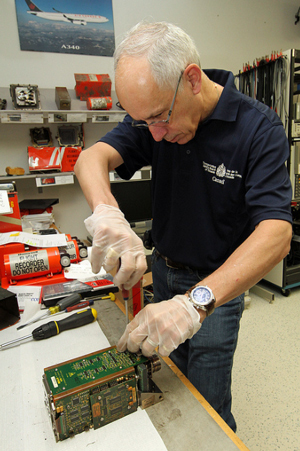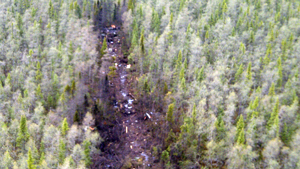No mechanical problems in fatal Ornge crash: investigators
Ornge to return other Sikorsky S76 helicopters to service
CBC News - Posted: Jun 4, 2013 11:17 AM ET
The Transportation Safety Board says there is no indication that mechanical
problems were a factor in the fatal Ornge helicopter accident near Moosonee,
Ont. last Friday.

Ted Givins, manager of recorder and vehicle performance with the Transportation
Safety Board, examines the cockpit voice recorder that was recovered from the
scene of the Ornge helicopter crash near Moosonee, Ont. The helicopter crashed
shortly after take-off on May 31, killing four people.(Transportation
Safety Board)
The Ontario air ambulance went down shortly after take-off, killing two
paramedics and two pilots.
The TSB investigator in charge, Daryl Collins, said his team was able to access
information from the cockpit voice recorder but he did not provide any further
details.
"What will happen now is the investigation team is going to be extensively
looking at company procedure, still continuing to look at technical records as
well, talking with the company and conducting numerous interviews,” he said.
Collins added investigators were able to obtain several other pieces of evidence
from the crash site, which are expected to help in the investigation.
On Friday, Ornge confirmed the names of the four who died in the crash:
- Captain Don Filliter, 54, of Skead, Ont.
- First Officer Jacques Dupuy 43, of Otterburn Park, Que.
- Paramedic Dustin Dagenais, 34, of Moose Factory, Ont.
- Paramedic Chris Snowball, 38, of Burlington, Ont.

The Transportation Safety Board released this picture of the Ornge helicopter
crash site near Moosonee on May 31.(Transportation
Safety Board)
"Their lives were lost serving the public, and we owe a deep debt of gratitude,"
said Dr. Andrew McCallum, president and CEO of Ornge.
The helicopter, one of six Sikorsky S76 choppers in Ornge's fleet, was built in
1980 and was certified by Transport Canada, McCallum said at news conference
Friday.
Ornge's five remaining S76 helicopters were taken out of service out of an
"abundance of caution," he added.
But on Tuesday, Ornge announced it would return them to service after the TSB
"did not raise concerns regarding the S76 fleet." The S76 helicopter is flown
out of bases in Thunder Bay and Kenora.
Ornge said it is developing alternative plans to restore helicopter service in
Mooseonee but, in the interim, fixed-wing aircraft is being used for patient
transport in the James Bay region.
The TSB probe is expected to take a year to complete.

